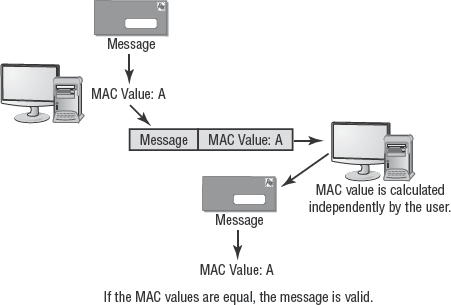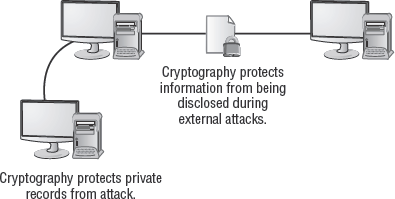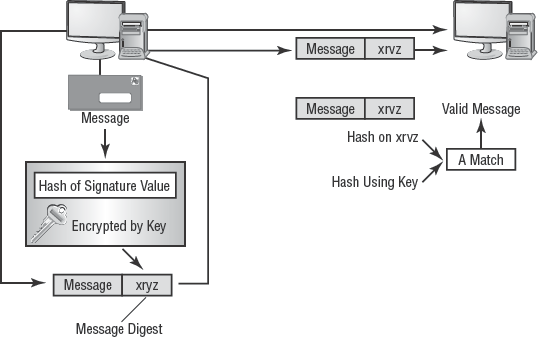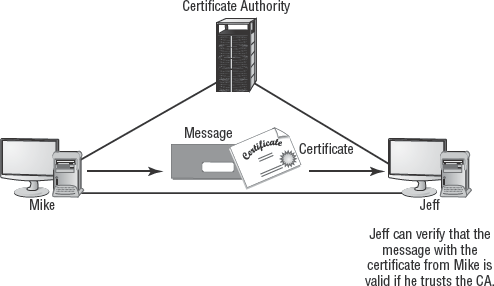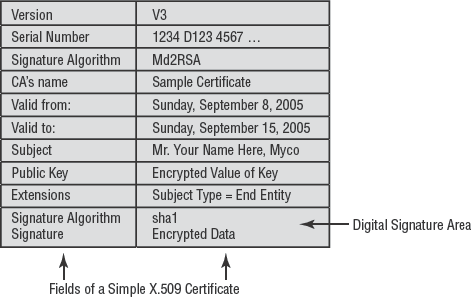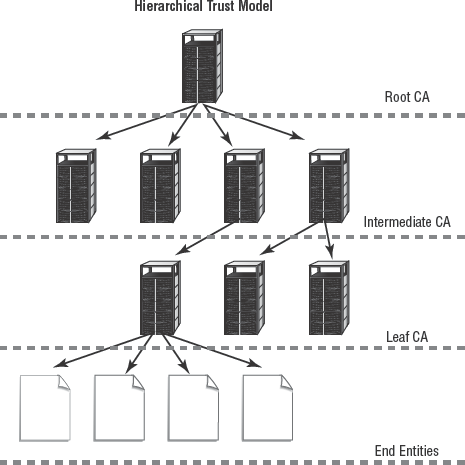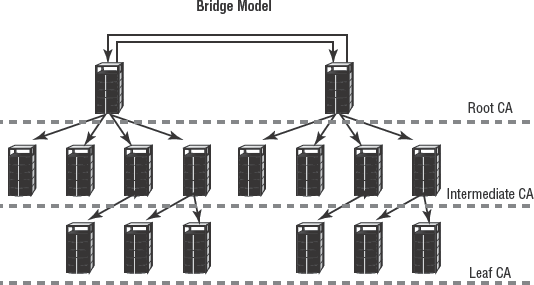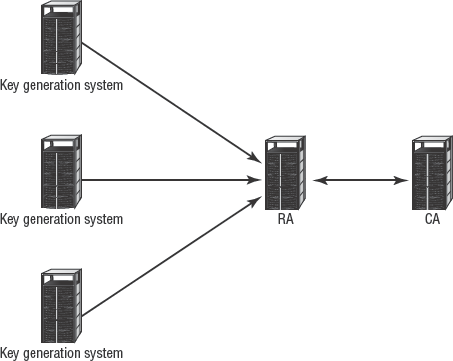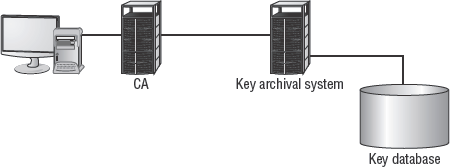The Following CompTIA Security+ Exam Objectives Are Covered in This Chapter:
4.1 Be able to identify and explain the following different kinds of cryptographic algorithms
Hashing
Symmetric
Asymmetric
4.2 Understand how cryptography addresses the following security concepts
Confidentiality
Integrity
Digital Signatures
Authentication
Non-Repudiation
Digital Signatures
Access Control
4.3 Understand and be able to explain the following concepts of PKI (Public Key Infrastructure)
Certificates
Certificate Policies
Certificate Practice Statements
Revocation
Trust Models
4.4 Identify and be able to differentiate different cryptographic standards and protocols
4.5 Understand and be able to explain the following concepts of Key Management and Certificate Lifecycles
Centralized vs. Decentralized
Storage
Hardware vs. Software
Private Key Protection
Escrow
Expiration
Revocation
Status Checking
Suspension
Status Checking
Recovery
M of N Control (Of M appropriate individuals, N must be present to authorize recovery)
Renewal
Destruction
Key Usage
Multiple Key Pairs (Single, Dual)

The full name of this section from the Security+ objectives list is "Be able to identify and explain the of the following different kinds of cryptographic algorithms". This first section in the cryptography domain is an introduction to the three basic divisions of cryptography. A firm grasp of these initial concepts will assist you in understanding the more complex issues presented in later sections of this domain.
Note
For more information on the various cryptography algorithms, see Chapter 7 of the Security+ Study Guide, Second Edition, by Sybex.
There are three basic divisions in cryptography: hashing, symmetric cryptography, and asymmetric cryptography. Hashing relates to a form of digital ID. The latter two relate to the type of encryption and decryption processes. You need to be familiar with each of these cryptography concepts and recognize examples of them.
Hashing is a type of cryptography that isn't an encryption algorithm. Instead, hashing is used to produce a unique identifier—known as a hash value, hash, checksum, message authentication code (MAC), fingerprint, or message digest—of data. The data could be a file, a hard drive, a network traffic packet, or an e-mail message. The hash value is used to detect when changes have been made to a resource. In other words, hashing is used to detect violations of data integrity.
For example, a hash value computed now may be compared with a hash value created last week. If the two values are the same, the data hasn't been changed. If the two values are different, then the data has been modified. Figure 4.1 shows the basic functionality of a hash or MAC value.
Unlike traditional cryptography, which transforms data into ciphertext, hashing produces a hash value without modifying the original data. Because of this special feature, hashing can be used to protect or verify data integrity. It can also be used to verify whether a copy procedure produced an exact duplicate of a data set. For example, when a hard drive is being imaged to create an exact duplicate (as is done in forensic investigations), a hash is produced of the original drive before the duplication process. Then a hash is produced of the original drive and the duplicate drive after the duplication process. If the two hashes of the original drive are the same, no modifications have occurred to the original drive. If the duplicate drive's hash value is the same as the original drive's, then that proves the duplicate is an exact copy of the original.
Hashing takes a variable-length input and produces a fixed-length output. For example, Message Digest 5 (MD5) is a 128-bit hash algorithm. This means that no matter what the size of the input data, the output hash will always be 128 bits long.
The strength of hashing is its one way-ness: It can be performed in only one direction. It isn't mathematically possible to convert a hash value back to its original data. Thus, if someone obtains your hash value, they won't be able to re-create the original data that produced the hash.
However, that isn't to say that hashing is totally attack proof. Hashing can be attacked using a method known as reverse engineering, reverse hash matching, or a birthday attack. These attack methods are commonly used by password-cracking tools. Most secure systems store passwords in their accounts database in hashed form. Hashes can't be performed in reverse, so this is generally a secure solution. However, since the hash algorithm used by commercial software is known (or can be easily discovered), password crackers can be written to exploit the stored password hashes. Attack tools compare hashes from potential passwords with the hashes stored in the accounts database. Potential passwords are either generated on the fly using all possible combinations of characters or pulled from a precompiled list of passwords (known as dictionary lists). Each potential password is hashed, and then that hash value is compared with the accounts database. If a match is found, the password cracker tool has discovered a password for a user account.
This form of hashing attack exploits the mathematical characteristic that if two messages are hashed and their hashes are the same, the messages must be the same. This can be written H(M)=H(M') then M=M'.
The most common or widely used hashing algorithms are as follows:
Secure Hash Algorithm (SHA-1)—160-bit hash value
Message Digest 5 (MD5)—128-bit hash value
Message Digest 4 (MD4)—128-bit hash value
Message Digest 2 (MD2)—128-bit hash value
Symmetric cryptography is also called private key cryptography or secret key cryptography. It uses a single shared encryption key to encrypt and decrypt data (see Figure 4.2). When symmetric cryptography is used to encrypt files on a hard drive, the user is the only person in possession of the single secret key. When symmetric cryptography is used to encrypt communications traffic, the two communication partners each have a copy of the one shared secret key. For example, the secure communication session protocol of Secure Socket Layer (SSL) uses symmetric cryptography. In either use, symmetric cryptography protects confidentiality.
Symmetric cryptography is very fast in comparison to asymmetric cryptography (discussed next). Its speed is due to the way its algorithms are designed and the fact that a single key is used to encrypt and decrypt data.
Symmetric cryptography provides for strong encryption protection when larger keys are used. However, the protection is secure only as long as the keys are kept private. If a symmetric key is compromised or stolen, it no longer offers true protection (just as your door lock no longer provides security if someone gets a copy of your house key).
Key exchange or distribution under symmetric cryptography is a common problem. To use symmetric cryptography to encrypt communications traffic between you and someone else over the Internet (or some other untrusted network), you must have a means to securely exchange the secret keys. If you already have a means to exchange the secret keys securely, why aren't you using that mechanism to communicate? Thus, some out-of-band communication solution must be implemented to securely exchange keys. Mechanisms include shipping a floppy with a key, reading it over the phone, or using a different network to transmit the key. However, the preferred method is to deploy a complete Public Key Infrastructure (PKI) solution that employs asymmetric cryptography to exchange symmetric cryptographic keys. The exchanged secret keys are used to encrypt the traffic for a single communication session; then they're discarded. PKI is simply a concept of how to deploy different aspects of various cryptography mechanisms into a single complete real-world solution.
Since each member of a network in a symmetric cryptography solution needs to have a shared secret key with every other member in order to support secure communications, n(n-1)/2 keys are needed. Thus, symmetric cryptography isn't scalable when used alone.
Symmetric cryptography is divided into two forms:
- Block cipher
A block cipher is a solution that works against a complete static data set. That data set is broken into fixed-length segments called blocks, and each block is encrypted separately.
- Stream cipher
A stream cipher is a solution that works against data that is constantly being produced on the fly. A buffer, much like a block, waits to be filled by data as it's produced. Once the buffer block is full, that block is encrypted and then transmitted to the receiver.
Other than the basic difference in whether the original data is preexisting and static or produced on the fly, both ciphers function in much the same manner. Unless the symmetric cryptography solution is based around a one-time pad (meaning every key is used only once), the same encryption key is used on each block or buffer block for a given data set or communication session.
The most widely used symmetric cryptography solutions are listed in Table 4.1.
Table 4.1. Common Symmetric Cryptography Solutions
Name | Block Size | Key Size (in bits) |
|---|---|---|
Advanced Encryption Standard (AES; uses the Rijndael block cipher algorithm) | Variable | 128, 192, and 256 |
Triple Data Encryption Standard (3DES) | 64 | 168 |
Data Encryption Standard (DES) | 64 | 56 |
International Data Encryption Algorithm (IDEA) | 64 | 128 |
Blowfish | Variable | 1–448 |
Twofish | 128 | 1–256 |
Rivest Cipher 5 (RC5) | 32, 64, 128 | 0–2048 |
Carlisle Adams/Stafford Tavares (CAST-128) | 64 | 128 |
Asymmetric cryptography is also called public key cryptography. It uses key pairs consisting of a public key and a private key (see Figure 4.3). Each communication partner in an asymmetric cryptography solution needs their own unique key pair set (i.e. a private key and a public key); this makes asymmetric cryptography much more scalable than symmetric. The private key of the key pair must be kept private and secure. The public key of the key pair is distributed freely and openly.
The public and private keys are related mathematically, but possession of the public key doesn't allow someone to generate the private key. Thus, the integrity of the private key is protected. In addition, the keys always work in unison: If the public key is used to encrypt data, only the private key can decrypt it. Likewise, if the private key is used to encrypt data, only the public key can decrypt it.
Asymmetric cryptography functions as follows:
The sender writes a message.
The sender encrypts the message with the sender's private key to produce the interim message package.
The sender encrypts the interim message package with the recipient's public key to produce the message package.
The sender transmits the message package to the recipient.
The recipient decrypts the message package using the sender's public key to produce the interim message package.
The recipient decrypts the interim message package using recipient's private key to extract the original message.
Asymmetric cryptography is much slower than symmetric cryptography, so it isn't generally suited for encrypting large amount of data. It's often used as the secure exchange mechanism for symmetric cryptographic keys. It provides several security services: authentication, integrity protection, and non-repudiation.
The most widely used asymmetric cryptography solutions are as follows:
Rivest Shamir Adleman (RSA)
Diffie-Hellman
Error Correcting Code (ECC)
El Gamal
- Hashing
Hashing is used to produce a unique data identifier. Hashing takes a variable-length input and produces a fixed-length output. It can be performed in only one direction. The hash value is used to detect violations of data integrity.
- Hashing attacks
Hashing can be attacked using a method known as reverse engineering, reverse hash matching, or a birthday attack. These attack methods are commonly used by password-cracking tools.
- Common hash algorithms
The common hash algorithms are Secure Hash Algorithm (SHA-1), which is a 160-bit hash value; Message Digest 5 (MD5), which is a 128-bit hash value; Message Digest 4 (MD4), which is a 128-bit hash value; and Message Digest 2 (MD2), which is a 128-bit hash value.
- Symmetric cryptography
Symmetric cryptography is also called private key cryptography or secret key cryptography. Symmetric cryptography uses a single shared encryption key to encrypt and decrypt data. It provides the security service of confidentiality protection.
- Strengths and weaknesses of symmetric cryptography
Symmetric cryptography is very fast in comparison to asymmetric cryptography. It provides for strong encryption protection when larger keys are used. However, the protection is secure only as long as the keys are kept private. Key exchange under symmetric cryptography is a common problem. Symmetric cryptography isn't scalable when used alone.
- Block ciphers
A block cipher is a solution that works against a complete static data set. That data set is broken into fixed-length segments called blocks, and each block is encrypted separately.
- Stream ciphers
A stream cipher is a solution that works against data that is constantly being produced on the fly. A buffer, much like a block, waits to be filled by data as it's produced. Once the buffer block is full, that block is encrypted and then transmitted to the receiver.
- Common symmetric cryptography solutions
The common symmetric solutions are Advanced Encryption Standard (AES), Triple Data Encryption Standard (3DES), Data Encryption Standard (DES), International Data Encryption Algorithm (IDEA), Blowfish, Twofish, Rivest Cipher 5 (RC5), and Carlisle Adams/Stafford Tavares (CAST-128).
- Asymmetric cryptography
Asymmetric cryptography is also called public key cryptography. It uses key pairs consisting of a public key and a private key. Each communication partner in an asymmetric cryptography solution needs only a key pair.
- Strengths and weaknesses of asymmetric cryptography
Asymmetric cryptography is scalable. The private key of the key pair must be kept private and secure. The public key of the key pair is distributed freely and openly. Possession of the public key doesn't allow someone to generate the private key. Asymmetric cryptography is much slower than symmetric cryptography. It provides three security services: authentication, integrity protection, and non-repudiation.
- Common asymmetric cryptography solutions
The common asymmetric solutions are Rivest Shamir Adleman (RSA), Diffie-Hellman, Error Correcting Code (ECC), and El Gamal.
The full name of this section from the Security+ objectives list is "Understand how cryptography addresses the following security concepts". Cryptography may provide one or more of the following security services: confidentiality, integrity, authentication, non-repudiation, and access control. We'll discuss each of these in the following sections.
Note
For more information on how cryptography addresses the various security concepts, see Chapter 7 of Security+ Study Guide, Second Edition, by Sybex.
There are several security services that a cryptographic solution may provide. Familiarity with these services will assist you on the exam.
Confidentiality protects the secrecy of data, information, or resources. It prevents or minimizes unauthorized access to data (see Figure 4.4). It ensures that no one other than the intended recipient of a message receives it or is able to read it. Confidentiality protection provides a means for authorized users to access and interact with resources, but it actively prevents unauthorized users from doing so.
Integrity is the security service that protects the reliability and correctness of data. Integrity protection prevents unauthorized alterations of data (see Figure 4.5). It ensures that data remains correct, unaltered, and preserved. Integrity protection provides a means for authorized changes to be implemented, but it actively prevents unauthorized changes to protected data. Integrity protection resists changes by unauthorized activities (such as viruses or intrusions) and accidents by authorized users (such as mistakes or oversights). Often an integrity check uses a hashing function to verify that data remains unchanged in storage or after transit.
One common example of a cryptographic solution that provides for integrity protection is a digital signature.
A digital signature is an electronic mechanism to prove that a message was sent from a specific user (that is, it provides for non-repudiation) and that the message wasn't changed while in transit (it also provides integrity). Digital signatures operate using a hashing algorithm and either a symmetric or an asymmetric encryption solution.
Digital signatures using asymmetric encryption solutions operate as follows:
The sender writes a message.
The sender computes a hash of the message.
The sender uses the sender's private key to encrypt the hash.
The sender attaches the encrypted hash to the message.
The complete message package is sent to the receiver.
The receiver strips off the encrypted hash.
The receiver uses the sender's public key to decrypt the hash.
The receiver computes a hash of the message.
The receiver compares the two hash values.
Digital signatures using symmetric encryption solutions (see Figure 4.6) operate as follows:
The sender writes a message.
The sender computes a hash of the message.
The sender uses the shared secret key to encrypt the hash.
The sender attaches the encrypted hash to the message.
The complete message package is sent to the receiver.
The receiver strips off the encrypted hash.
The receiver uses the shared secret key to decrypt the hash.
The receiver computes a hash of the message.
The receiver compares the two hash values.
In either case, if the hash values match, then the recipient gets verification that integrity was maintained and that the sender did send the message (non-repudiation). If the hash values don't match, then the recipient doesn't have verification of either integrity protection or non-repudiation.
Authentication verifies the identity of the sender or recipient of a message. In cryptography terms, authentication occurs differently in symmetric cryptography than it does in asymmetric cryptography. In symmetric cryptography, a single shared secret key is held only by the two communication partners. Thus, when an encrypted message is received and is properly decrypted by the recipient's copy of the shared secret key, authentication occurs. The recipient is authenticated because possession of the correct key proves that this is the correct recipient of the encrypted message. Likewise, the sender is authenticated because the recipient's ability to extract an intelligible message from the received encrypted material using the secret key proves that the sender, the only other user with possession of the same secret key, encrypted and sent the message.
In asymmetric cryptography, a sender uses the recipient's public key to encrypt data. This forces authentication of the recipient since the recipient is the only user in possession of the corresponding private key. Likewise, when the sender's private key is used to encrypt data, then any recipient can verify the sender's identity by decrypting that data with the sender's public key.
Non-repudiation prevents the sender of a message or the perpetrator of an activity from being able to deny that they sent the message or performed the activity. In symmetric cryptography, non-repudiation is supported when a recipient is able to decrypt a message using the shared secret key. This proves that the other holder of the shared secret key is the actual sender who sent the message. In asymmetric cryptography, non-repudiation is supported when a sender's private key is used to successfully decrypt a message. This proves that the sender's private key was used to encrypt the data. Since the sender is the only user who has possession of the sender's private key, no one else could have encrypted and sent the message.
One common example of a cryptographic solution that provides for non-repudiation is a digital signature.
Access control restricts access to secured data to authorized users. Cryptographic access control is enforced through the concept of possession of encryption keys. In a symmetric cryptography solution, a maximum of two people have valid possession of the shared secret key. Thus possession of the shared secret key is proof of authorization: The holder of the shared secret key is authorized to access anything encrypted with that key. In asymmetric cryptography, only one person is in valid possession of the private key. Thus, possession of the private key is proof of authorization: The holder of the private key is authorized to access anything encrypted with the corresponding public key.
- Confidentiality
Confidentiality prevents or minimizes unauthorized access to data. It ensures that no one other than the intended recipient of a message receives it or is able to read it.
- Integrity
Integrity protection prevents unauthorized alterations of data. It ensures that data remains correct, unaltered, and preserved. Integrity protection provides a means for authorized changes to be implemented, but it actively prevents unauthorized changes to protected data.
- Digital signatures
A digital signature is an electronic mechanism to prove that a message was sent from a specific user and that the message wasn't changed while in transit. Digital signatures operate using a hashing algorithm and either a symmetric or an asymmetric encryption solution.
- Authentication
The security service that verifies the identity of the sender or receiver of a message is authentication.
- Non-repudiation
Non-repudiation prevents the sender of a message or the perpetrator of an activity from being able to deny that they sent the message or performed the activity.
- Access control
Access control restricts access to secured data to authorized users. Cryptographic access control is enforced through the possession of encryption keys.
The full name of this section from the Security+ objectives list is "Understand and be able to explain the following concepts of PKI (Public Key Infrastructure)". Public Key Infrastructure (PKI) isn't a product; rather, it's a blueprint or concept for a solution. It dictates what should happen and which standards to comply with, but it doesn't indicate which technologies or algorithms to use.
Note
For more information on PKI, see Chapter 7 of the Security+ Study Guide, Second Edition, by Sybex.
PKI focuses on proving the identity of communication partners, providing a means to securely exchange session-based symmetric encryption keys through asymmetric cryptographic solutions, and providing a means to protect message integrity through the use of hashing. Most PKI solutions are based around certificates and the use of a certificate authority (CA). The issue of certificates includes concepts of revocation and trust models.
Certificates serve a single purpose: proving the identity of a user or the source of an object. They don't provide proof as to the reliability or quality of the object or service to which they're attached; they only provide proof of where that product or service originated.
Certificates work under a theory known as the trusted third party. This theory states that if user A trusts user C and user B trusts user C, then user A can trust B and vice versa. With certificates, the trusted third party is a certificate authority (CA) (see Figure 4.7). If two users have certificates issued by the CA, then the two users can trust each other's identity. Certificates work this way on the Internet and within private organizations.
Most certificates used on the Internet and within private networks are based on the X.509 version 3 certificate standard. This standard dictates how certificates are to be constructed and their required components, such as the subject's public key, the CA's distinguishing name, a unique serial number, and the type of symmetric algorithm used for the certificate's encryption (see Figure 4.8).
A user or a subject uses the following procedure to obtain a certificate:
The subject requests a certificate from a CA.
The request process includes proof of the subject's identity and the subject's public key.
The CA verifies the identity of the subject.
The CA creates the certificate.
The CA validates the certificate by signing it with the CA's private key.
The CA issues the certificate to the subject.
Another entity known as a registration authority (RA) may be deployed in a CA solution. The RA can't create new certificates; rather it serves as a distribution point for the certificate revocation list (CRL) and possibly as an Online Certificate Status Protocol (OCSP) host (see the later section "Revocation"). CAs must have defined certificate policies and certificate practice statements.
A certificate policy is a PKI document that serves as the basis for common interoperability standards and common assurance criteria. Certificate policies are acceptable use policies for certificates: They dictate what is and isn't acceptable with regard to how certificates can be used in an organization. The policies are a set of rules that control how certificates are used, managed, and deployed.
Certificate policies must
be clear and concise.
be endorsed by senior management.
be restricted to a maximum length of two pages.
be written in squfet-point statements.
be able to provide users (also referred to as subjects) with a clear understanding of the acceptable use policies with regard to certificates.
A certificate practice statement (CPS) describes how a CA will manage the certificates it issues. The CPS details how certificate management is performed, how security is maintained, and the procedures the CA must follow to perform any type of certificate management from creation to revocation.
Certificates have a specific expiration date, which is sometimes called the lifetime date. Once that date is reached, a certificate is automatically rejected as invalid. However, a CA may have cause to revoke or invalidate a certificate before its predefined expiration date. Revocation is the process by which a CA invalidates a certificate.
Revocation may occur because the subject's identity information has changed, the subject used the certificate to commit a crime, or the subject used the certificate in such a way as to violate the CA's certificate policy.
When a certificate is revoked, it's added to the CA's CRL. Once a certificate's expiration date is reached, it's removed from the CRL, since the timestamp automatically invalidates the certificate. Thus, the CRL contains only those certificates that have been revoked but have yet to expire. Figure 4.9 shows the certification revocation process.
The CRL is freely distributed to all users and applications. You should always consult it before accepting a certificate. When issued to a requesting user or application, a CRL is assigned a lifetime date as well. When the CRL exceeds this lifetime, it can no longer be relied on, and you should obtain a new, updated version of the CRL.
When a user application, such as a web browser, receives a certificate from a server, such as a web server, the application first verifies that the date on the certificate is still valid. Next, it checks the local copy of the CA's CRL. If the CRL is no longer valid, an updated copy of the CRL is obtained. The application checks to see whether the certificate appears on the CRL. If it doesn't, the application presents the certificate to the user for a final acceptance choice. The user can elect to accept or reject the certificate as well as indicate whether to make this same acceptance or rejection choice for all future instances of this certificate.
The CRL process is widely used, but it isn't the only mechanism for informing users and applications about the status of certificates. Online Certificate Status Protocol (OCSP) is another solution that functions on a direct query basis. Each time an application receives a new certificate, it sends a query to an OCSP CA server. The CA responds directly to indicate whether the certificate is still valid or has been revoked. By using OCSP, large CRLs aren't transmitted repeatedly to every requesting system, and queries are direct, immediate, and current.
The term trust model refers to the structure of the trust hierarchy used by a certificate authority system. The basic trust model scheme used by CAs is a hierarchical structure with a single top-level root CA. Below the root CA are one, two, or more subordinate CAs. Below each subordinate CA may be one, two, or more subordinate CAs, and so on. Subordinate CA's can sometimes be called intermediate or leaf CAs. In this model, all CAs have a single parent CA, but they may have multiple child CAs (see Figure 4.10). The root CA is the start of trust; all CAs and participants in a hierarchical trust model ultimately rely on the trustworthiness of the root CA.
Cross-certification occurs when a CA from one organization elects to trust a CA from another organization (see Figure 4.11). This is also called a bridge trust structure. In this way, certificates from either organization are accepted by the other organization. In most cases, the root CA is configured to trust the other root CA.
A trust list is a form of trust model where a web browser or similar application is provided a list of root certificates of trusted CAs. The web browser trusts numerous sources of certificates because of the presence of the trusted CA's root certificate on the list of trusted CAs.
- Certificates
Certificates serve a single purpose: proving the identity of a user or the source of an object. Certificates don't provide any proof as to the reliability or quality of the object or service to which they're attached; they only provide proof of where that product or service originated.
- Trusted third parties
Certificates work under a theory known as the trusted third party: If user A trusts user C and user B trusts user C, then user A can trust B and vice versa. With certificates, the trusted third party is a certificate authority (CA).
- x.509 version 3 certificate standard
Most certificates are based on the X.509 version 3 certificate standard. Some of the required components are the subject's public key, the CA's distinguishing name, a unique serial number, and the type of symmetric algorithm used for the certificate's encryption.
- Procedure for requesting a certificate
To request a certificate, a subject submits a request to a CA with proof of their identity and their public key.
- Certificate policies
A certificate policy is a PKI document that serves as the basis for common interoperability standards and common assurance criteria. It's a statement that governs the use of digital certificates within an organization. Certificate policies are acceptable use policies for certificates.
- Certificate practice statements (CPS)
A CPS describes how a CA will manage the certificates it issues. It details how certificate management is performed, how security is maintained, and the procedures the CA must follow to perform any type of certificate management from creation to revocation.
- Revocation
A CA may have cause to revoke or invalidate a certificate before its predefined expiration date. Revocation may occur because the subject's identity information has changed, the subject used the certificate to commit a crime, or the subject used the certificate in such a way as to violate the CA's certificate policy.
- Certificate revocation lists (CRL)
When a certificate is revoked, it's added to the CA's CRL. The CRL is freely distributed to all users and applications. It should always be consulted before accepting a certificate.
- How a web browser handles new certificates
When a web browser receives a certificate from a web server, it verifies that the date on the certificate is still valid. Next, it checks the local copy of the CA's CRL. If the CRL is no longer valid, an updated copy of the CRL is obtained. The application checks to see if the certificate appears on the CRL. If it doesn't, the application presents the certificate to the user for a final acceptance choice.
- Online Certificate Status Protocol (OCSP)
OCSP is a revocation solution that functions on a direct query basis. Each time an application receives a new certificate, it sends a query to an OCSP CA server. The CA responds directly to indicate whether the certificate is still valid or has been revoked.
- Trust models
The term trust model refers to the structure of the trust hierarchy used by a certificate authority system. The basic trust model scheme used by CAs is a hierarchical structure.
- Hierarchical trust models
A hierarchical structure has a single top-level root CA. Below the root CA are one, two, or more subordinate CAs. The root CA is the start of trust. All CAs and participants in a hierarchical trust model ultimately rely on the trustworthiness of the root CA.
- Cross certification
Cross certification occurs when a CA from one organization elects to trust a CA from another organization. In this way, certificates from either organization are accepted by the other organization. In most cases, the root CA is configured to trust the other root CA.
- Trust lists
A trust list is a form of trust model where a web browser or similar application is provided with a list of root certificates of trusted CAs. The web browser trusts numerous sources of certificates because of the presence of the trusted CA's root certificate on the list of trusted CAs.
The full name of this section from the Security+ objectives list is "Identify and be able to differentiate different cryptographic standards and protocols". The Security+ exam assumes you'll be able to differentiate between symmetric and asymmetric cryptography systems as well as hashing algorithms. You should be able to recognize specific examples of all three forms of cryptography.
Note
This section is purposefully brief because all of the issues and concepts that should appear here are already discussed in other objective areas where they are specifically named.
Note
For more information on identifying and differentiating cryptography standards and protocols, see Chapter 8 of the Security+ Study Guide, Second Edition, by Sybex.
The full name of this section from the Security+ objectives list is "Understand and be able to explain the following concepts of Key Management and Certificate Lifecycles". This section addresses the various aspects of controlling and handling cryptographic keys and digital certificates.
Note
For more information on key management and certification lifecycles, see Chapter 8 of the Security+ Study Guide, Second Edition, by Sybex.
Key management is the term used to describe the various mechanisms, techniques, and processes used to protect, use, distribute, store, and control cryptographic keys. A key management solution should follow these basic rules:
The key should be long enough to provide the necessary level of protection.
Keys should be stored and transmitted securely.
Keys should be truly random, should use the full spectrum of the keyspace (the range of valid values that can be used as a key for a specific algorithm), and should never repeat.
The lifetime of a key should correspond to the sensitivity of the data it's protecting.
The more a key is used, the shorter its lifetime should be.
Keys should be backed up or escrowed in case of emergency.
Keys should be properly destroyed at the end of their lifetime.
In addition to these basic concepts, the remainder of this section discusses other important issues in regards to key management.
Centralized key management gives complete control of cryptographic keys to the organization and takes control away from the end users. A centralized key-management solution requires a significant investment in infrastructure, processing capabilities, administrative oversight, and communication bandwidth.
In a centralized management solution, copies of all cryptographic keys are stored in escrow. This allows administrators to recover keys in the event that a user loses their key, but it also allows management to access encrypted data whenever it chooses.
Other important aspects of centralized key management are that keys must be created only on secured, dedicated servers; keys can be distributed only to authorized users and only in a secure fashion; keys can be modified only by administrators; and revocation of keys and corresponding digital certificates is at the discretion of the organization. Figure 4.12 shows an example of a centralized key management solution.
Centralized key management is often unacceptable to a user community since it provides them with no control over their privacy, confidentiality, or integrity. In fact, every key generated by the centralized system is stored in escrow. Therefore, nothing encrypted by an end user is completely private, since an administrator could extract the key from escrow and use it to decrypt a message or file.
An alternate scheme is known as decentralized key management. In this type of environment, end users generate their keys (whether symmetric or asymmetric) and submit keys only as needed to centralized authorities (see Figure 4.13). For example, to request a digital certificate, an end user would transmit only their public key to the CA. The end user's private key is always kept private so they're the only entity in possession of it. Plus, since the public key is already public, its compromise won't result in a complete compromise of the end user's secured solution.
In a decentralized key management system, end users are ultimately responsible for managing their own keys and using escrow to provide fault tolerance. If an end user fails to take the necessary precautions, a lost or corrupted key could mean the loss of all data encrypted with that key.
Cryptographic keys and digital certificates should be stored securely. If a private key (asymmetric) or a secret key (symmetric) is ever compromised, then the security of all data encrypted with those keys is lost. Reliable storage mechanisms must be used to protect cryptographic keys. There are two methods or mechanisms for storing keys: hardware based or software based.
Keys can be stored in either software solutions or hardware solutions. Both offer unique benefits and shortcomings. A software solution offers flexible storage mechanisms and, often, customizable options. However, such a solution is vulnerable to electronic attacks (viruses or intrusions), may not properly control access (privilege-elevation attacks), and may be deleted or destroyed. Most software solutions rely on the security of the host operating system, which may not be sufficient.
Hardware solutions aren't as flexible. However, they're more reliable and more secure than software solutions. Hardware solutions may be expensive and are subject to physical theft. If a user isn't in physical possession of the hardware storage solution, they can't gain access to the secured or encrypted resources. Some common examples of hardware key storage solutions include smartcards and flash memory drives.
In a symmetric system, all entities in possession of the shared secret key must protect the privacy and secrecy of that key. If the key is compromised anywhere or by anyone, the entire solution (all entities using the same key) is compromised (everything protected by that key).
In an asymmetric system, each end user must protect their private key. If an end user's private key is ever compromised, then only that one end user's security is lost. All other users in the environment aren't directly affected by the key compromise.
Key escrow is a storage process by which copies of private keys and/or secret keys are retained by a centralized management system (see Figure 4.14). This system securely stores the encryption keys as a means of insurance or recovery in the event of a disaster. In terms of cryptography, a disaster is when a key is lost or damaged. If such a key is stored in escrow, it can be recovered by a key escrow agent and used to recover any data encrypted with the damaged or lost key.
However, escrow can be seen in another light if you're an end user intent on obtaining complete and total security. If you're assigned your private key or secret key, then the issuing CA (or cryptographic server) probably retains a copy of the key in escrow. This means that at any time a key recovery agent could pull your key out of escrow and use it to decrypt anything you've encrypted with your public key or your secret key without your permission. Obviously, key escrow works great in private corporate environments, but it doesn't apply well to the public Internet.
Note
An important aspect of key escrow is key recovery. That topic is covered in a later, in the section "Recovery."
Most cryptographic keys and all certificates have a built-in expiration date. Upon reaching that date, the key or certificate becomes invalid, and no system will accept it. Keys and certificates are assigned a lifetime with control settings known as valid from and valid to dates. Keys and certificates past their valid to dates should be discarded or destroyed.
If the valid to date for a key or certificate is approaching, you should request a renewal. If you fail to renew before the lifetime expires, then you must perform the complete request process from scratch.
Keys and certificates can be revoked before they reach their lifetime expiration date.
Note
This topic was discussed in section "4.3 Revocation."
Suspension is an alternative to revocation. Suspension can be used when a key or certificate will be temporarily removed from active use but the subject (or the CA) doesn't wish to invalidate it. When a key or certificate is suspended, it can't be used to sign or encrypt any new items, but previously signed or encrypted items can be verified or decrypted. The key or certificate can be reactivated at a later date.
Suspension status checking is an extension of revocation status checking. However, the results indicate whether a certificate or key is currently valid or in suspension (such a status would be labeled certification hold).
Note
Revocation status checking is discussed in sections "4.3 Certificates" and "4.3 Revocation."
Recovery is the process of pulling a key or certificate from escrow. Recovery can be used when a user loses their key or their key has been corrupted. This process can also be used to extract a key for the purpose of decrypting data even when the user still has valid possession of their key. The latter option may be necessary in a private corporate environment, but it's unacceptable in a public environment, such as the Internet.
Key recovery can only be performed by a key recovery agent. The key recovery agent is an administrative-level user who has the encryption key to the escrow database. They can decrypt and extract the necessary key from the escrow database and either give a copy to the user or use the key to decrypt all data. If the latter occurs (as is common in most cryptographic solution implementation), the end user must be issued a new key, which must be used in turn to re-encrypt all the data that should be secured.
A key recovery agent should be a trusted individual. If the environment doesn't warrant the trust of a single key recovery agent, a mechanism known as M of N control can be implemented. M of N control indicates that there are multiple key recovery agents (M) and that a specific minimum number of these key recovery agent (N) must be present and working in tandem in order to extract keys from the escrow database. The use of M of N control ensures accountability among the key recovery agents and prevents any one individual from having complete control over or access to a cryptographic solution.
Renewal is the process by which a key or certificate is reissued with an extended lifetime date before the key or certificate expires. The renewal process doesn't require a complete repeat of the request and identity proofing process; rather, the old key (which is about to expire) is used to sign the request for the new key. This allows the CA to quickly determine whether the end user's key or certificate can be immediately extended (or reissued with a new lifetime date) or rejected and revoked according to its existing lifetime dates. The decision of the CA often depends on the end user's compliance with the organization's certificate policy (the acceptable use policy for the key or certificate).
After a key or certificate is no longer needed or it has expired or been revoked, it should be properly disposed of. This process is known as key destruction: the removal of the key or certificate from all software and hardware storage devices. For keys and certificates that are still valid, the CA should be informed about the destruction of the key or certificate. This action allows the CA to update its CRL and OCSP servers.
Reasons to use key destruction include going out of business, changing identity, or having obtained replacement keys or certificates.
Cryptographic keys and digital certificates can be used in a wide variety of applications. Cryptographic keys, both symmetric and asymmetric, are involved in numerous security and protection solutions. These include the following:
Virtual private network (VPN) protocols such as IPSec
Communication security protocols such as Secure Sockets Layer (SSL) and Transport Layer Security (TLS)
The application of SSL to protect web traffic as in HTTP over SSL (HTTPS)
Proprietary web communication security protocols such as Secure HTTP (SHTTP)
Secure remote administration solutions, such as Secure Shell (SSH)
E-mail security solutions, such as Pretty Good Privacy (PGP) and Secure MIME (S/MIME)
In some situations, you may use multiple key pairs. One key set might be used for authentication and encryption and the other for digital signatures. This allows the first key pair to be escrowed and included on data backups of a centralized key-management scheme. The second key set is then protected from compromise, and the privacy of the owner's digital signature is protected, preventing misuse and forgery.
- Key management basics
Keys should be long enough to provide the necessary level of protection, should be stored and transmitted securely, should be random, and should use the full spectrum of the keyspace. In addition, they should be escrowed, properly destroyed at the end of their lifetime, used in correspondence with the sensitivity of the protected data, and have a shortened use lifespan if they're used repeatedly.
- Centralized key management
Centralized key management gives complete control of cryptographic keys to the organization and takes control away from the end users. In a centralized management solution, copies of all cryptographic keys are stored in escrow.
- Decentralized key management
In decentralized key management, end users generate their keys (whether symmetric or asymmetric) and submit keys only as needed to centralized authorities. The end user's private key is always kept private so they are the only entity in possession of it.
- Key storage
Cryptographic keys and digital certificates should be stored securely. If a private key (asymmetric) or a secret key (symmetric) is ever compromised, then the security of all data encrypted with the key is lost.
- Software key storage
A software solution offers flexible storage mechanisms and, often, customizable options. However, a software solution is vulnerable to electronic attacks (viruses or intrusions), may not properly control access (privilege-elevation attacks), and may be deleted or destroyed. Most software solutions rely on the security of the host OS, which may not be sufficient.
- Hardware key storage
Hardware solutions aren't as flexible. However, they're more reliable and more secure than software solutions. Hardware solutions may be expensive and are subject to physical theft. If a user isn't in physical possession of the hardware storage solution, they can't gain access to the secured or encrypted resources. Some common examples of hardware key storage solutions include smartcards and flash memory drives.
- Private key protection
In a symmetric system, all entities in possession of the shared secret key must protect the privacy and secrecy of that key. If the key is compromised anywhere or by anyone, the entire solution (all entities using the same key) is compromised (everything protected by that key).
- Key escrow
Key escrow is a storage process by which copies of private keys and/or secret keys are retained by a centralized management system. This system securely stores the encryption keys as a means of insurance or recovery in the event of a lost or corrupted key.
- Key expiration
Most cryptographic keys and all certificates have a built-in expiration date. Upon reaching that date, the key or certificate becomes invalid, and no system will accept it. Keys and certificates are assigned a lifetime with control settings known as valid from and valid to dates. Keys and certificates past their valid to dates should be discarded or destroyed.
- Key revocation and status checking
Keys and certificates can be revoked before they reach their lifetime expiration date. Status checking is the process of checking the lifetime dates against the current system date, checking the CRL, and/or querying an OCSP server.
- Key suspension
Suspension is an alternative to revocation. It can be used when a key or certificate will be temporarily removed from active use but the subject (or the CA) doesn't wish to outright invalidate the key or certificate. Suspension allows a key or certificate to be reactivated at a later date.
- Key recovery
Recovery is the process of pulling a key or certificate from escrow. The recovery process can be used when a user loses their key or their key has been corrupted. Only a key recovery agent can perform key recovery.
- M of N control
If the environment doesn't warrant the trust of a single key recovery agent, a mechanism known as M of N control can be implemented. M of N control indicates that there are multiple key recovery agents (M) and that a specific minimum number of these key recovery agent (N) must be present and working in tandem in order to extract keys from the escrow database.
- Key renewal
Renewal is the process by which a key or certificate is reissued with an extended lifetime date before it expires. The renewal process is doesn't require a complete repeat of the request and identity proofing process; rather, the old key (which is about to expire) is used to sign the request for the new key.
- Key destruction
After a key or certificate is no longer needed or it has expired or been revoked, it should be properly disposed of. For keys and certificates that are still valid, the CA should be informed about the destruction of the key or certificate. This action allows the CA to update its CRL and OCSP servers.
- Key usage
Cryptographic keys and digital certificates can be used in a wide variety of applications. Cryptographic keys, both symmetric and asymmetric, are involved in numerous security and protection solutions. Uses include VPN, IPSec, SSL, TLS, HTTPS, SHTTP, SSH, PGP, and S/MIME.
- Use of multiple key pairs
In some situations, you may use multiple key pairs. One key set might be used for authentication and encryption and the other for digital signatures. This allows the first key pair to be escrowed and included on data backups of a centralized key management scheme. The second key set is then protected from compromise, and the privacy of the owner's digital signature is protected, preventing misuse and forgery.
Hashing is used to test, prove, or verify which security service?
Authentication
Confidentiality
Integrity
Non-repudiation
Which of the following symmetric encryption algorithms offers the strength of 168-bit keys?
Data Encryption Standard
Triple DES
Advanced Encryption Standard
IDEA
Diffie-Hellman is what type of cryptographic system?
Asymmetric
Symmetric
Hashing
Certificate authority
The security service that protects the secrecy of data, information, or resources is known as what?
Integrity
Authentication
Non-repudiation
Confidentiality
Digital signatures can be created using all but which of the following?
Asymmetric cryptography
Hashing
Key escrow
Symmetric cryptography
Certificates have what single purpose?
Proving identity
Proving quality
Providing encryption security
Exchanging encryption keys
When a subject or end user requests a certificate, they must provide which of the following items? (Choose all that apply.)
Proof of identity
Hardware storage device
Public key
Private key
From a private corporate perspective, which of the following is most secure?
Decentralized key management
Centralized key management
Individual key management
Distributed key management
The mechanism used by a key-management system to provide fault tolerance to private keys is called what?
Revocation
Enrollment
Suspension
Escrow
When should a key or certificate be renewed?
Every year
Every quarter
Just before it expires
Just after it expires
C. Hashing is used to test whether the integrity of data has been violated. Asymmetric cryptography provides authentication, integrity, and non-repudiation. Symmetric cryptography provides confidentiality.
B. Triple DES offers the strength of 168-bit keys. DES offers the strength of 56-bit keys. AES offers the strength of 128, 192, or 256-bit keys. IDEA offers the strength of 128-bit keys.
A. Diffie-Hellman is an asymmetric cryptographic system. DES and AES are examples of symmetric cryptography. MD5 and SHA-1 are examples of hashing. Certificate authorities issue certificates based on an implemented PKI solution.
D. The security service that protects the secrecy of data, information, or resources is known as confidentiality. Integrity protects the reliability and correctness of data. Authentication verifies the identity of the sender or receiver of a message. Non-repudiation prevents the sender of a message or the perpetrator of an activity from being able to deny that they sent the message or performed the activity.
C. Key escrow isn't used in digital signatures, but it's a fault-tolerance feature of certificate and key management. Asymmetric and symmetric cryptography along with hashing are used in digital signatures.
A. Certificates have the single purpose of proving identity. They don't prove quality or provide encryption security, and they aren't used to exchange encryption keys.
A, C. Proof of identity and the subject's public key must be provided to the CA when requesting a certificate. The private key should never be revealed to anyone, not even the CA. A hardware storage device is used after a key or certificate has been issued, not as part of the requesting process.
B. Centralized key management is more secure, or at least more desirable, from a private corporate perspective. From a public or individual perspective, decentralized key management is more secure. Individual and distributed key management are nonstandard terms that could be used to refer to decentralized key management.
D. Escrow is the mechanism used by a key-management system to provide fault tolerance to private keys. Revocation is the invalidation of keys or certificates before their lifetime dates have expired. Enrollment is when a user requests a new certificate. Suspension is when a key or certificate is temporarily removed from active.
C. Keys and certificates should be renewed just before they expire. All the other choices are incorrect.

